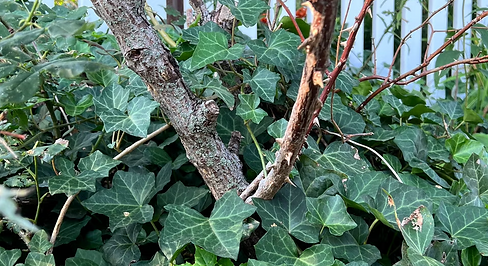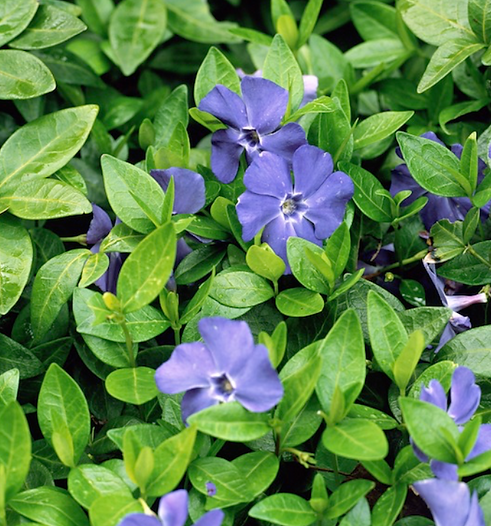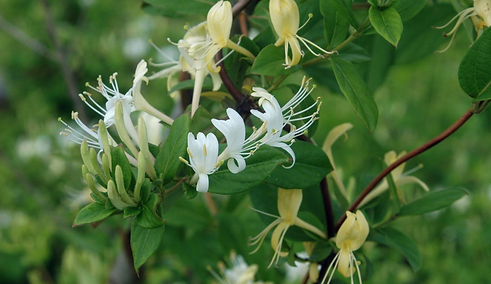Planting for
the Planet
Common Invasive Species Sold in Ontario
Garden centres and nurseries sell invasive plants to uninformed customers creating a primary pathway for their introduction. Many gardeners are unintentionally harming local biodiversity buy planting common invasive species in their backyards.
See below for examples of commonly sold invasive species, and suggested alternatives!
English Ivy
Hedera helix
English Ivy was introduced to Ontario by European Settlers as an ornamental plant. English Ivy creates dense carpets on the forest floor and in the forest canopy blocking sunlight and nutrients for other organisms affecting their survival. The weight English Ivy bears on trees can weaken their branches, damage their bark and leave them more susceptible to wind damage leading to death.
(Fraser Valley Invasive Species Society , n.d.)
Alternative: Canadian Wild Ginger
Photo Retrieved From: The Independent



Burning Bush
Euonymus alatus
The Burning Bush is native to Asia and was introduced to Ontario becoming a popular shrub due to its vibrant colour. This species is enjoyed by birds leading to seed dispersal. This damages native plant species since their seeds get dispersed less. Additionally, they form thick, dense coverings blocking sunlight and nutrients from other organisms.
(The Invasive Species Centre, n.d.)
Photo Retrieved From: Gardener's Path
Lily-of-the-Valley
Convallaria majalis
Lily-of-the-Valley is native to Eurasia and it spreads underground through modified roots called rhizomes. Lily-of-the-Valley creates a dense groundcover and out competes other organisms for space and light.
(GMI, n.d.)
Photo Retrieved From: American Meadows


Periwinkle
Vinca minor
Periwinkle is native to the Mediterranean basin and is commonly planted as a ornamental, ground-covering plant. Periwinkle spreads over large areas, outcompeting native plants for space, nutrients and light threatening local biodiversity.
(Ontario Parks, n.d.)
Photo Retrieved From: Bamboo Plants
Winter Creeper
Euonymus fortunei
Winter Creeper is a durable plant native to Asia, and is able to invade almost any environment and survive a wide range of conditions. This species can take on a range of forms, from a vine or ground cover to a dense shrub.
(Invasive.org, 2010)
Alternative: Canadian Wild Ginger
Photo Retrieved From: Woody Invasives of the Great Lakes


Goutweed
Aegopodium podagraria
Goutweed was introduced as an ornamental plant. Similar to other invasive plants, it creates a dense ground cover blocking sunlight and nutrients to reach native species disrupting local biodiversity.
(Ontario Parks, n.d.-b)
Alternative: Virginia Water-Leaf
Photo Retrieved From: PCA Alien Plant Working Group
Japanese Honeysuckle
Lonicera japonica
Hailing from Asia, the Japanese Honeysuckles poses many issues to native biodiversity and wildlife. Honeysuckles are able to produce toxic chemicals that prevent other plants growing in the area, and can outcompete other species for resources. Further, the fruits produced are not as nutritious compared to native species, and interfere with pollination of native species thereby reducing seed production.
(OISAP, n.d.)
Alternative Species: Fly Honeysuckle
Photo Retrieved From: SICIM


Daylily
Hemerocallis fulva
The Daylily is native to Asia and is widespread in Ontario gardens because of its hardiness and ability to spread. Its ability to spread has caused it to spread out of gardens and into surrounding ecosystems. The Daylily can displace native plants and alter the ecosystem dynamics they invade
(Ontario Parks, n.d.-c)
Alternative: Wood Lily
Photo Retrieved From: Illinois Wildflowers
References
American Meadows. (n.d.). Rosea Lily of the Valley, Convallaria. American Meadows. Retrieved March 11, 2024, from https://www.americanmeadows.com/product/perennials/lily-of-the-valley-rosea
Bamboo Plants. (n.d.). Vinca minor “Bowles.” BambooPlants.ca. Retrieved March 11, 2024, from https://bambooplants.ca/product/bowles-periwinkle-vinca-minor-bowles/
Butler, J. (2022, July 5). How to Grow and Care for Euonymus Shrubs | Gardener’s Path. Gardener’s Path. https://gardenerspath.com/plants/ornamentals/grow-euonymus/
Damiano, J. D. (2023, August 29). Invasive and ubiquitous, English ivy can hurt trees and plants. Removing it isn’t easy. The Independent. https://www.independent.co.uk/news/english-ap-united-states-trees-new-world-b2401206.html
Fraser Valley Invasive Species Society . (n.d.). English Ivy (Hedera helix). Fviss.ca. https://fviss.ca/invasive-plant/english-ivy
Garske, S., & Schimpf, D. (n.d.). PCA Alien Plant Working Group - Goutweed (Aegopodium podgraria). Www.invasive.org. https://www.invasive.org/alien/fact/aepo1.htm
GMI. (n.d.). A Guide for Southern Ontario Beautiful Non-Invasive Plants for your Garden. Retrieved March 11, 2024, from https://www.ontarioinvasiveplants.ca/wp-content/uploads/2020/02/GMI-South-_-PDF-_-Edition-3-2020-NEW.pdf
Illinois Wildflowers. (2019). Orange Day Lily (Hemerocallis fulva). Illinoiswildflowers.info. https://www.illinoiswildflowers.info/weeds/plants/or_daylily.htm
Invasive.org. (2010, November 11). Winter Creeper (Euonymus fortunei). Www.invasive.org. https://www.invasive.org/alien/pubs/midatlantic/eufo.htm
OISAP. (n.d.). Invasive Honeysuckles | Ontario’s Invading Species Awareness Program. Ontario Invasive Species Awareness Program. https://www.invadingspecies.com/invaders/plants/invasive-honeysuckles-2/
Ontario Parks. (n.d.-a). Planning Documents for Ontario Parks. Www.ontarioparks.ca. Retrieved March 11, 2024, from https://www.ontarioparks.ca/documents/content/10/203
Ontario Parks. (n.d.-b). Planning Documents for Ontario Parks. Www.ontarioparks.ca. Retrieved March 11, 2024, from https://www.ontarioparks.ca/documents/content/10/190
Ontario Parks. (n.d.-c). Planning Documents for Ontario Parks. Www.ontarioparks.ca. Retrieved March 11, 2024, from https://www.ontarioparks.ca/documents/content/10/204#:~:text=2.6%20Daylily
SICIM. (2021, February 1). February 2021 Invasive Plant of the Month: Japanese Honeysuckle. State of Indiana Cooperative Invasives Management. https://www.sicim.info/news/invasiveofthemonthfebruary2021
The Invasive Species Centre. (n.d.). THE INVASIVE SPECIES CENTRE INVASIVE PLANTS FACT SHEETS EUNONYMUS. Retrieved March 11, 2024, from https://www.torontomastergardeners.ca/wp-content/uploads/2021/10/Euonymus-Final-Edit-reduced.pdf
Woody Invasives of the Great Lakes . (2019, July 9). Wintercreeper - WIGL. Woody Invasives. https://woodyinvasives.org/woody-invasive-species/wintercreeper/